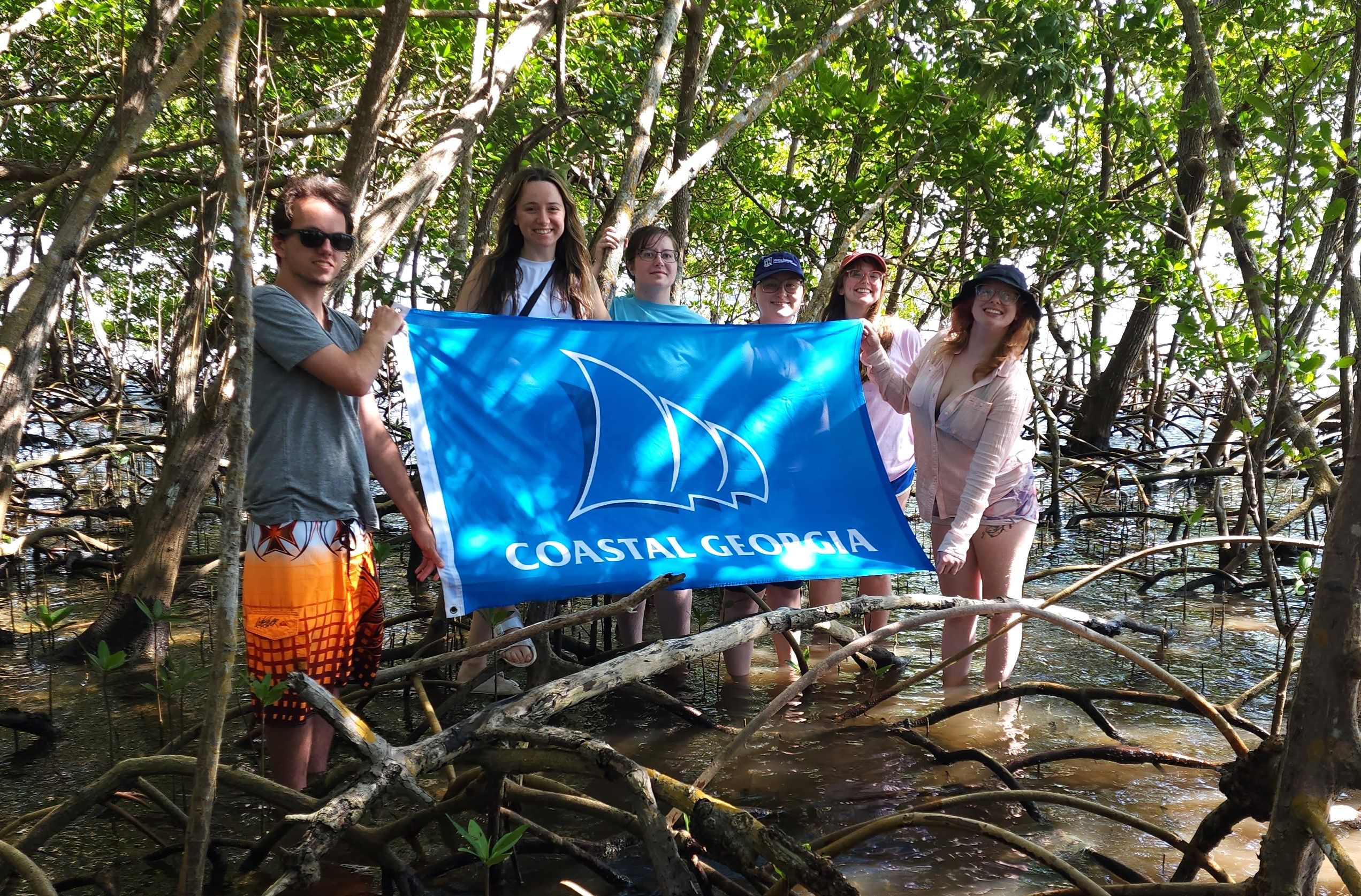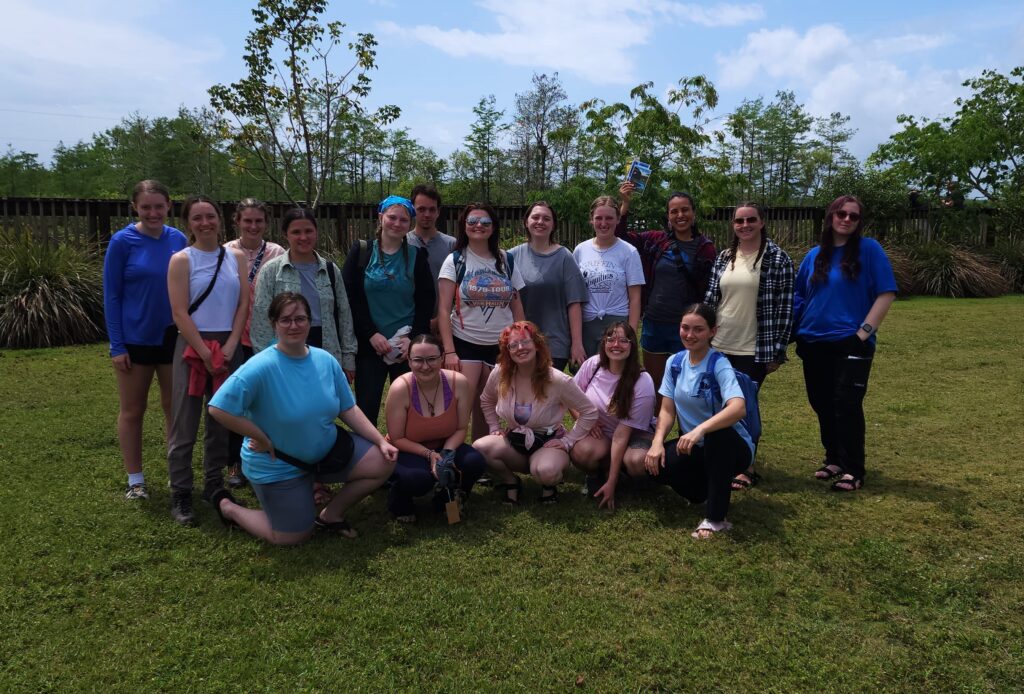
An Immersive Experience in the Everglades
Wading chest deep in the Everglades in the rain is definitely an experience that one would never forget. This is what a group of students from the College of Coastal Georgia’s Environmental Science Program experienced as they learned firsthand about the function and benefits of wetlands.
Wetlands provide important benefits for the environment, such as protecting and improving water quality, providing habitats for fish and wildlife, storing floodwaters, and maintaining surface water flow during dry periods. Over time, human development and modifications to wetland areas have reduced these functions, however, there are many ongoing projects focusing on restoring wetlands.
Environmental science students from a variety of classes, including wetland restoration and global climate change, set out together with their instructors, for a unique field experience to the Everglades on March 21-24. The first stop on the trip was Sweetwater Wetlands Park in Gainesville, Florida. Sweetwater consists of more than 125 acres of wetlands and ponds that were created to improve the water quality of wetlands in Paynes Prairie Preserve State Park and the Floridian Aquifer. Assistant Professor of Geology Dr. Robin McLachlan was one of the faculty members that accompanied students on the trip. McLachlan explained that when rain falls, the water picks up things along the way that can find their way into the Floridian Aquifer, where Gainesville residents get their drinking water. For example, rain water will pick up oil while flowing over parking lots, pesticides from gardens, trash, cigarette butts, large appliances, and more. This contaminated water flows through ditches and into streams before discharging into wetlands, which eventually flows into the Floridian Aquifer. If wetland areas are healthy and expansive, they naturally filter the water.
“Prior to 2010, the wetlands were not healthy, and many contaminants were found in the drinking water. Rather than invest in upgrading the old water treatment plant, the city decided to build Sweetwater Wetlands Park to allow the land to perform its natural water-purifying function,” McLachlan said. “This park is an example of how nature-based management can be less expensive and just as effective, if not more effective, than a traditional water-treatment facility, while also providing vital habitats for a variety of organisms, such as birds, butterflies, and alligators.”
Students learned about the Comprehensive Everglades Restoration Plan (CERP), the single largest restoration program in South Florida. It is a partnership between the state and federal government to restore, protect, and preserve the region’s water resources. Their next stop was Lake Okeechobee to learn about the Lake Okeechobee Watershed Restoration Project—a CERP project. The purpose of this project is to increase water storage capacity, improve the quality and timing of water discharging into surrounding estuaries, restore vital wetlands, and improve water supply. Okeechobee is located near the center of the state, and over 30 miles from the Atlantic coast, but it is only 26 feet above sea level.
“Looking ahead, and considering climate change, if we remain on a high emissions pathway, the sea level is expected to rise six feet by the year 2100. Category 5 storm surges have reached 20 feet in this part of Florida,” McLachlan said. “Adding this all together, Lake Okeechobee could be inundated if a Category 5 storm hits in 75 years unless we rapidly implement effective climate mitigation strategies.”
This realization stood out for many students on the trip, McLachlan said.
Although it rained throughout their trip, it didn’t stop them from wading into the natural ecosystem of the Everglades. Senior Caroline Harley is a biology major with a concentration in environmental science. She went on the trip because “the Everglades is such a unique environment and a crucial wetland.”
“I had never been on a wet walk before and it was amazing! I was fascinated by the plant diversity that we saw. There were air plants bigger than basketballs, huge cypress trees with a bunch of new leaves, and a ton of plants I’d never even seen before,” Harley said. “We saw a few crawfish during the walk, but nothing too much bigger due to the rain. It was downpouring on us while we walked, but we were up to our waists in water anyway. It was an experience like no other.”
Harley described the flooding as an adventure. She loves camping, but when she stepped out of her tent at one point during the night, she was ankle-deep in water. Harley said it was still a great time. What stood out to her the most was the variety of plants.
“I am a really big plant person, so it was amazing seeing plants that I’d only ever read about. The Everglades is such a unique wetland with plant diversity that doesn’t compare to what we have around us,” Harley said. “I think I may have given a few friends of mine a laugh by literally jumping up and down when I saw a few plant species I’d only ever read about. It’s definitely one of the highlights of my college experience.”
During the trip, students also learned about the history of Seminole Indians and how much of the native vegetation can be used for medicinal and practical purposes. They also saw the interactions between geomorphology, which is the shape of the land, and ecologic function. For example, alligators are often found near the plant alligator flag because it grows along the edges of deep ponds, McLachlan said.
“Being immersed in this space, which is a natural wonder unlike anywhere else in the world, students don’t just listen to the stories, they can almost see and feel them actually occurring around them,” McLachlan said. “Experiences like this make it so much easier for students to comprehend the importance of these ecosystems, not just to the outside world, but also to us where we live.”

Providing Immersive Experiences
The mission of the Environmental Science Program is to provide a student-centered, experienced-based education that empowers students to become lifelong learners and accomplished professionals. Trips like the one to the Everglades gives students a chance to experience and see what they’ve learned in the classroom in the real world.
“These experiential learning opportunities have been shown to increase understanding and form lasting memories more so than traditional learning. Students also get to meet real people with real jobs and real stories, to gain perspectives and career ideas they may have never had otherwise,” McLachlan said.
Many of the students had never been camping before, and the trip was a tough crash course. However, they walked away more confident about living and working outside.
“It rained nearly nonstop for the first three days, and our first two nights we slept in the pouring rain. When faced head on with this struggle, students quickly learned how to set up their tents efficiently and correctly tie tarps and drive stakes,” McLachlan said. “It’s what I call type two fun—miserable in the moment, but an experience that we now look back on fondly as one of the coolest trips of our lives.”
Through these types of experiences, graduates of the program are prepared to investigate, translate, and communicate environmental science in a way that promotes meaningful participation and cultural affairs as well as the global, technological society.
The trip was sponsored by Glenn Hansen, the Discovery Center for the Marine, and Environmental Sciences.
“The donation from one person allowed 19 students to take part in a possibly life-altering experience,” McLachlan said. “Experiential learning is not free, and we are incredibly grateful to all of our sponsors.”
To donate towards or sponsor a field experience, visit https://www.ccga.edu/about/offices/advancement/environmental-science-funding/
Sponsor Opportunities:
Maymester – a three-week long field tour of Georgia
Coastal Research Methods – includes a one-week trip to the UGA Marine Institute on Sapelo Island
Scientific Diving Certificate